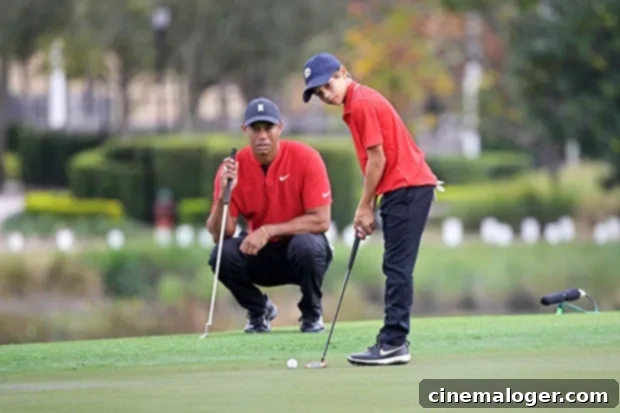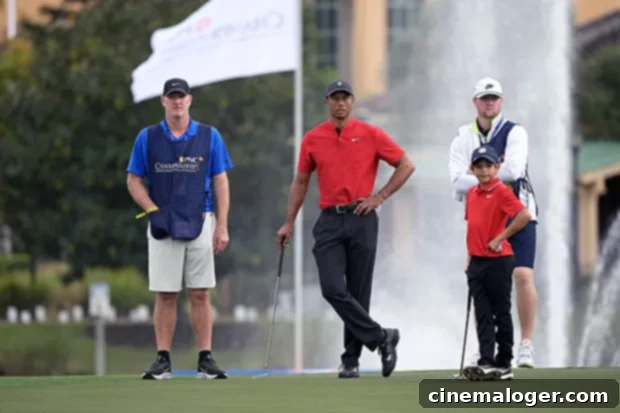Tiger Woods’ Parental Dilemma: Navigating Son Charlie’s Golf Career Amidst Personal Recovery
In the annals of golf history, few names resonate with the power and legacy of Tiger Woods. Yet, beyond the major championships and groundbreaking records, a more personal narrative unfolds, one centered on his 12-year-old son, Charlie Woods. Before the life-altering car accident in February, Tiger, 45, offered a rare glimpse into his complex feelings about Charlie potentially following in his formidable golfing footsteps. This intimate discussion took place during the premiere episode of A Round with Tiger: Celebrity Playing Lessons, a new Golf Digest series. The episode, notably filmed merely a day prior to Tiger’s Feb. 23 car wreck, featured the golf icon in conversation with actress Jada Pinkett Smith, where he openly shared observations on Charlie’s burgeoning passion for the sport.
Tiger noted Charlie’s natural inclination, remarking, “He just watched me do it and just kind of does it.” This mirroring of natural talent is particularly poignant, as Tiger himself honed his extraordinary skills from a remarkably young age under the tutelage of his late father, the esteemed pro Earl Woods. The echoes of his own upbringing are undeniable, yet they bring with them a unique set of reservations for Tiger as a father. While he recognizes Charlie’s inherent ability and growing interest, Tiger harbors a protective instinct, expressing a nuanced desire for his son’s future in golf that deviates from simply replicating his own.
A Father’s Complex Emotions: Navigating Charlie’s Golfing Journey
Despite the obvious joy Tiger finds in sharing the sport with his son, a deeper, more emotional layer underlies his perspective. “I just don’t want him to hate the game,” Tiger confided in Jada Pinkett Smith. This sentiment reveals a profound understanding of the immense pressures that accompany a career in professional golf, particularly when one bears the surname Woods. Tiger, who endured unrelenting scrutiny and expectations throughout his career, is acutely aware of the potential pitfalls. He articulated a strong desire to shield Charlie from what he termed “that trap,” referring to the intense, all-consuming demands that can strip the joy from a beloved pastime. This raw admission underscores a father’s struggle to reconcile his son’s natural talent with the harsh realities of the professional spotlight.
The conversation became notably emotional for Tiger, touching upon his own formative experiences. “I get emotional about it,” he shared. “Some of my best memories are being out there with my dad.” This reflection harks back to his legendary bond with Earl Woods, a relationship built on mentorship, shared passion, and a deep understanding of the game. Tiger’s instruction to Charlie, like “Left hand grip just a touch more. There you go,” illustrates not just technical guidance but a continuation of that familial legacy, a passing of knowledge from one generation to the next. It’s a delicate balance for Tiger, wanting to foster Charlie’s love for golf while simultaneously protecting him from the potential burdens of an unparalleled legacy. Tiger shares both Charlie, and his daughter Sam, 14, with his ex-wife Elin Nordegren, emphasizing his role as a devoted father beyond the golf course.

Charlie Woods: The Young Talent Emerges on the Course
While Tiger expresses his reservations, he has also proudly introduced Charlie to the competitive arena, allowing his son’s impressive skills to shine. One of the most memorable instances was in December 2020, when the iconic duo competed together at the 2020 PNC Championship. This esteemed tournament, formerly known as the “Father/Son Challenge,” provides a unique platform for major champions to compete alongside a family member. It was during this event that Charlie Woods truly captured the attention of the golf world, displaying a talent far beyond his years. His composure, swing mechanics, and strategic thinking mirrored those of his famous father, sparking widespread excitement and drawing comparisons to a young Tiger himself.
During the championship, Charlie executed an incredible shot, a near-eagle that showcased his precision and power. The moment brought a wide, beaming smile to Tiger’s face, a testament to the immense pride he felt watching his son’s performance. The father-son bond was palpable throughout the tournament, enhanced by their matching bright purple golf shirts, a symbolic gesture that delighted fans and commentators alike. It wasn’t just Charlie’s skill that was impressive; it was his demeanor and obvious enjoyment of the game, aspects Tiger clearly cherishes and wishes to preserve.
A month prior to the tournament, Tiger had already expressed his enthusiasm to GOLFTV. “I can’t tell you how excited I am to be playing with Charlie in our first official tournament together,” he told the outlet. “It’s been great watching him progress as a junior golfer, and it will be incredible playing as a team together in the PNC Championship.” Tiger further elaborated on Charlie’s development, noting that his son was “starting to understand how to play. He’s asking me the right questions.” This active engagement and intellectual curiosity about the game are precisely what Tiger hopes to foster, allowing Charlie to develop his own passion and approach rather than feeling compelled to emulate his father. “I’ve kept it competitive with his par, so it’s been just an absolute blast to go out there and just be with him. It reminds me so much of me and my dad [growing up],” he added, again drawing parallels to his own treasured experiences with Earl.

The Road Ahead: Tiger’s Grueling Recovery and Future Ambitions
The heartwarming moments with Charlie and the insightful conversations on A Round with Tiger were abruptly overshadowed by a devastating event. As noted, Tiger’s new show was filmed just the day before he suffered severe injuries in a horrific car wreck in Southern California. On February 23, 2021, Tiger lost control of his car, which subsequently rolled down an embankment on the border of Rolling Hills Estate and Rancho Palos Verdes. The accident resulted in traumatic injuries to his right leg, including open fractures to both his tibia and fibula, a bruised rib cage, and lacerations to his lower front jaw. These extensive injuries have presented a formidable challenge, marking perhaps the most arduous recovery process of his storied career.
Since the accident, Tiger has not been able to return to the golf course in a competitive capacity. The path to recovery has been long and arduous, requiring intensive physical therapy and a profound test of his famous resilience. He has frequently been seen using crutches as he navigates the ongoing rehabilitation process, a stark reminder of the severity of his injuries and the commitment required to regain his mobility.
Speaking about his post-accident rehab on May 27, Tiger candidly admitted the unprecedented difficulty of this particular challenge. “This has been an entirely different animal,” he stated, emphasizing the distinction from his previous encounters with injury. “I understand more of the rehab processes because of my past injuries, but this was more painful than anything I have ever experienced.” This declaration highlights the immense physical and emotional toll the accident has taken, even for an athlete renowned for his pain tolerance and unwavering determination. The pain, coupled with the slow, incremental progress, demands a level of mental fortitude that few possess.
More Than Just a Game: Legacy, Family, and the Future of the Woods Name
When questioned about his aspirations to return to professional golf, Tiger offered a pragmatic and grounded response, revealing his singular focus on the immediate future. “My physical therapy has been keeping me busy. I do my routines every day and am focused on my No. 1 goal right now: walking on my own. Taking it one step at a time.” This statement underscores a shift in perspective, at least temporarily, from competitive triumphs to fundamental human capabilities. The journey back to the green, if it ever happens, will be a testament to his indomitable spirit, but for now, his priority lies in personal recovery and rebuilding his physical foundation.
Tiger’s journey, both as a golf legend and as a father, continues to captivate. His reservations about Charlie’s potential career are not born of a desire to discourage but rather a profound understanding of the relentless pressures and sacrifices involved in pursuing greatness at the highest level. His experience with his own father, Earl, instilled in him a love for the game, but also showed him the dedication required. Now, as Charlie displays his own undeniable talent, Tiger navigates the delicate balance of nurturing his son’s passion while protecting him from the less glamorous aspects of professional stardom.
The future of the Woods name in golf remains an intriguing prospect. While Tiger focuses on his grueling rehabilitation, the sight of Charlie Woods on the course evokes memories of a young phenom who redefined the sport. Whether Charlie ultimately chooses to follow a professional path or simply enjoys golf as a cherished pastime with his father, Tiger’s guidance will undoubtedly prioritize his son’s well-being and genuine happiness. The conversations filmed before the accident offer a poignant insight into the heart of a father who, despite his own ongoing battles, remains deeply invested in shaping a joyful and fulfilling future for his children, one swing at a time.
